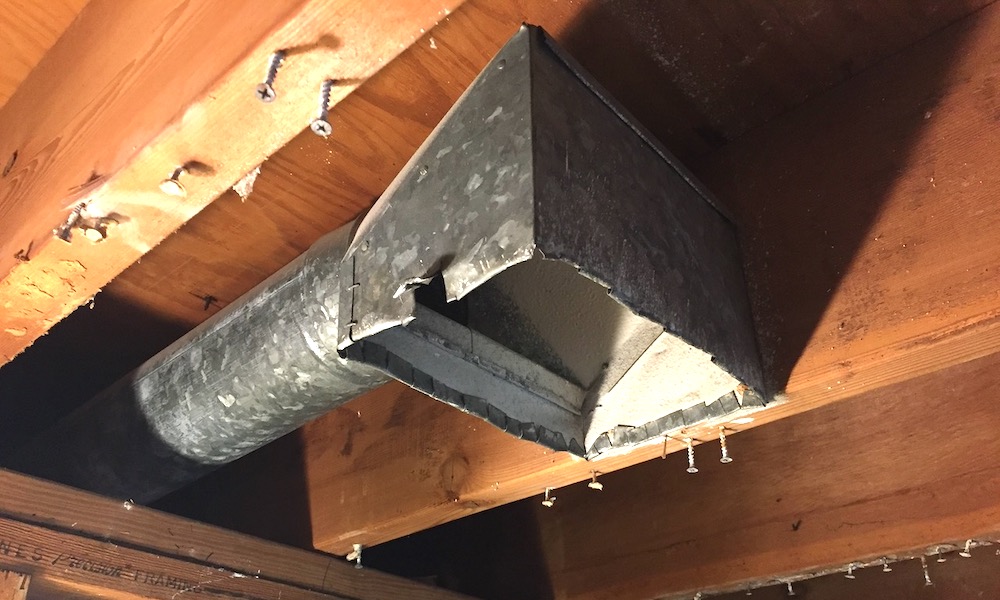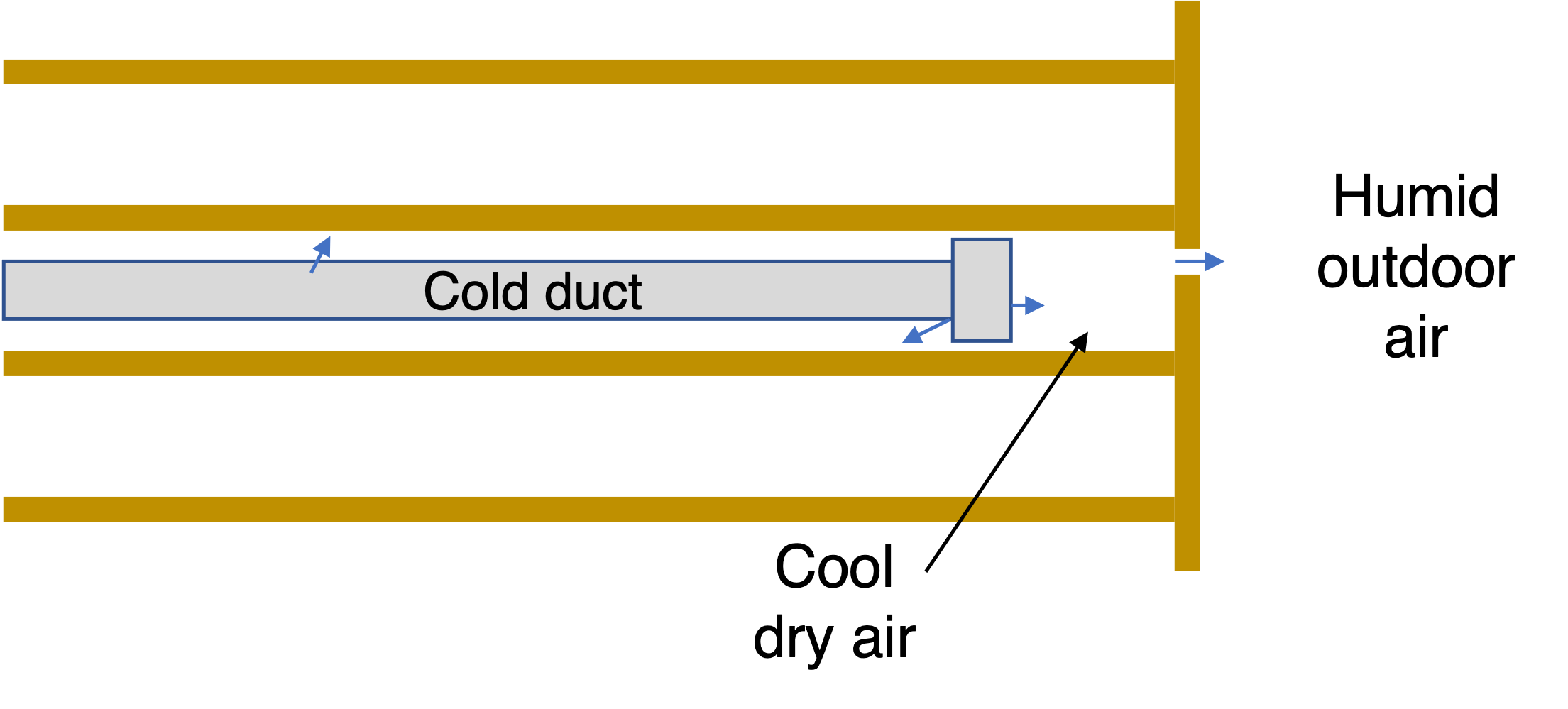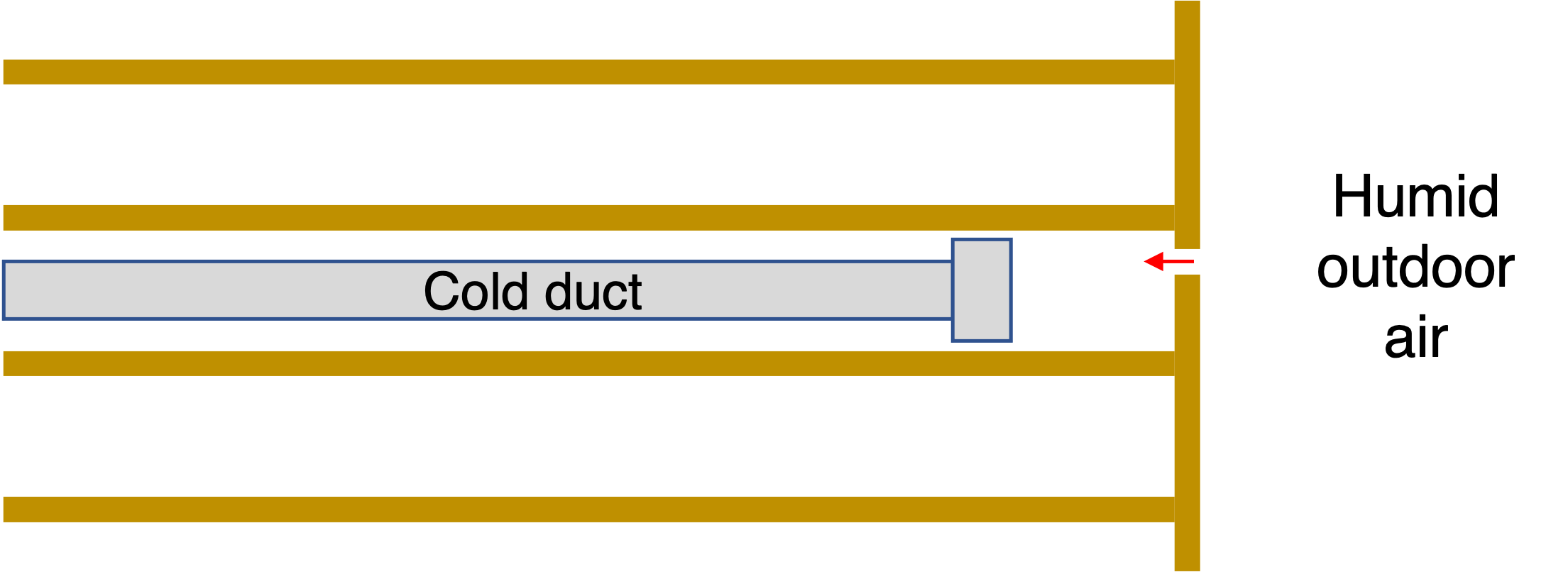Can Duct Sealing Lead to Condensation?

When can doing something good for your house turn into something bad? Hmmm. There are way too many answers to that question, so let me narrow it down. Is it possible to make your ducts more airtight, a good thing, and see your house suddenly have a condensation and mold problem it never had before? Let explain.
Old houses and leaky ducts
I’ve been dealing with a house on the humid, Eastern side of the US lately. It was built in the middle of the 20th century and hasn’t had a lot of improvements to make it more energy efficient. It’s got a fairly high air leakage rate, as tested with a blower door. It does have double-pane windows but little insulation.
The problem, though, is with the sheet metal ducts. Or, more correctly, it’s with the interaction between those ducts and the surrounding air when the central air conditioner runs in the summer. The ducts have been in there a long time, and they didn’t have this problem until the past few years.
The lead photo above isn’t from the house in question, but it shows a common feature: uninsulated sheet metal ducts in the interstitial spaces created by framed floors. This house has a basement, where the equipment is, and two floors above. The ducts run through chases and floor joists.
What changed?
Two things happened before the condensation started. First, they had the ducts sealed. Yes, it’s possible to seal ducts that are locked away above a drywall ceiling. There’s an aerosolized duct sealant that can be blown into the ducts to seal holes up to nearly half an inch in size.
The other thing they did was to have the air conditioner replaced. The new air conditioner may have had something to do with it, but it’s not oversized. If anything, it may even be too small for the cooling load.
After the homeowner had those two things done, the house developed a condensation problem. The uninsulated ducts above the drywall in the some of the ceilings got wet. They found out about the problem when that water dripped down onto the ceiling below. And when they opened up the ceiling, they found mold.
How could condensation occur?
Condensation occurs when humid air finds a cool surface. Strictly speaking, the surface temperature needs to be at or below the dew point temperature of the air. When you’ve got an uninsulated sheet metal supply duct carrying cold air, you’ve got a low surface temperature. All you need for condensation is air that has a dew point temperature higher than the duct temperature.
For this to happen, one of two things had to happen. Either ducts were colder after the work was done, or the air was more humid. Or it could have been both. If the ducts got colder than they had been before, the fault would probably lie with the air conditioner. If the air near the ducts got more humid, the duct sealing is probably to blame. I believe it’s the duct sealing in this case. Here’s how.
Condensation after duct sealing
How could sealing the ducts cause condensation? Well, leaky ducts lose cool, dry air into those interstitial spaces. The diagrams below show how that could cause condensation.

When the ducts were leaking into those joist cavities, they did two things that reduced the potential for condensation. First, they spilled cool, dehumidified air into those spaces. Second, they put a positive pressure there. The diagram above shows a hole in the band joist on the right. With a positive pressure in the cavity, the dry air leaks out, to be replaced by more dry air. That positive pressure keeps the humid outdoor air from leaking into the space around the duct.

Once the duct is sealed, dry air doesn’t leak into the cavity (or not as much anyway). That means the cavity also doesn’t get positively pressurized. It’s hard to know what the actual pressures after the duct sealing would have been, but it’s certainly possible that humid outdoor air leaked into the cavity after the duct sealing.
Have you seen this happen?
I feel confident about this analysis, but I don’t have data from before the duct sealing and air conditioner replacement to confirm it absolutely. Have you seen anything like this? Do you know of any studies on this phenomenon? Does this explain what’s happening in a house you’ve worked on? Comment below and let me know your thoughts.
Allison A. Bailes III, PhD is a speaker, writer, building science consultant, and the founder of Energy Vanguard in Decatur, Georgia. He has a doctorate in physics and writes the Energy Vanguard Blog. He also has a book on building science coming out in 2022. You can follow him on Twitter at @EnergyVanguard.
Related Articles
Buried Ducts Risk Condensation in Humid Climates
Why Do Air Conditioning Vents Sweat?
Building Science Word of the Day: Interstitial
3 Important Facts About Dew Point Temperature
Comments are moderated. Your comment will not appear below until approved.
This Post Has 17 Comments
Comments are closed.

Another possibility, sealing ducts increases static pressure resulting in less airflow. Less airflow means colder temperatures in ducts. I agree with your assessment and have seen this before. It can get really bad when you replace a single speed AC unit with a variable speed and it runs in dehumidify mode.
Thanks,
Dewey
Allison – Almost certainly the correct answer. – A good example of applying the right approach at the wrong time. Order of work is as, or more, important when performing remedial work.
I’ve seen a similar issue when a homeowner spray foamed their attic. The ducts were also uninsulated. The space was considerably cooler, allowing the ducts to drop below the dew point, with the same result of condensation pooling up in several locations. – In that home, I believe sealing the floors from crawl space and exterior envelopes from gulf coast humidity First, would have reduced, or eliminated tge problem.
Allison, I just re-read your 2012 article about stack effect, and I do not want to end up in the Building Science Fight Club! 😉
The arrows through a hole in the band joist (in before and after diagrams) may not necessarily be in the directions as depicted? The three levels in this house amplify the stack effect and wouldn’t summer arrow through the hole be pointing outward, at least in the 1st floor band joist?
The comment above lacks merit if we are talking about ducts within 2nd floor system.
Allison, I always appreciate and enjoy your clear explanations of these topics. Keep up the good work!
I generally agree with your analysis that the duct sealing is the cause of the condensation. I would solve this by adding a fresh air intake from the outside so as to create an overall positive air pressure for the house. This would recreate the effect of the formerly leaky duct where the dry, conditioned (leaked) air pushed out the moisture- laden outside air. This would also reduce the amount of allergens/pollen/dust that are being pulled into the house because of the (assumed) negative pressure of the house that exists today.
Should supply ducts that travel up 8ft to the floor above be insulated? What about ducts above a drywall ceiling in a basement?
See it a lot. We fix a lot of duct sweating issues and we also sell Aeroseal. One thing we tell customers is that if you seal the ducts and you already have sweating, it will make it worse.
See it more with people who have sealed ducts but then have attic fans.
In terms of likely probability, I like your hypothesis in re the interstitial space made negative by sealing the ducts. A classic case of an unintended consequence. Maybe a blower door test is in order to focus on that possibility.
I would not, however, rule out the new HVAC without at least a quick gander at the system’s indoor temperature split – return vs supply temperature. Tech should check static pressure, as well. If the system has a variable speed air handler check for active dehumidification configuration – this can dial back air flow when humidity is higher than setpoint – increases run time and wrings more moisture out of the air, but may also result in duct condensation.
Lastly, do not neglect cooling setpoints – these sometimes take some sleuthing to suss out since occupants aren’t always truthful or may be unaware of the habits of others in the home – teens etc with their own thermostat / system / zone setting it inappropriately. I advise asking “The Question” in two parts: “What (temperature) do you normally set the system at?” and then, crucially “…any lower at night?”. Life / health / household changes sometimes lead to reduced setpoints. In my area in and around Jax, FL, we try to steer clear of anyone setting any system below 72*F. Those that set below that are best served by one of our competitors.
All of these are situations I have encountered in the course of duct sweat investigations
Based on limited information provided, your proposed diagnosis seems reasonable. If leakage evidence tends to be in close proximity of exterior walls, that would be a smokin’ gun.
I’ve seen a number of articles over the years about how duct sealing can cause problems to the extent that it impacts airflow. When working on BPI-3300, I argued that duct sealing should always be accompanied by airflow testing to ensure adequate airflow in cooling mode. Your diagnosis in this case suggests that’s not enough to guarantee “no harm” from duct sealing. Supply duct leakage may have been the only thing preventing interstitial infiltration at the band joist (rim bands are notorious for air leakage).
Another possibility is that the HVAC contractor set the fan to “Continuous” or advised the owner to do so. We know that can raise indoor humidity.
Regardless of the cause, buildings have many complex interactions and while it’s certainly possible to avoid duct condensation with proper design and installation practice, the surest defense is to minimally insulate the ducts in a way that also provides a vapor barrier. I think it’s unfortunate that the IRC/IMC doesn’t require this in the “A” and “C” climate zones.
As an aside… A senior code official with the North Carolina Dept of Insurance (code regulatory authority) once told me that while building codes don’t require interior ducts to be insulated (they should), contractors are nonetheless liable for any damage caused if the ducts sweat. I’m curious how other states address this issue, if at all. Do any jurisdictions require insulated interior ducts?
Certainly possible. But this assumes the premise that only leakage from the supply side was keeping the interstitial space pressurized. How about the return side?
Is it possible that before there was predominantly supply side air leakage and now after the aeroseal there predominant return side leakage? Same effect I suppose. Can the ducts be re-tested but separating the return from the supply perhaps? This would serve a huge purpose from a diagnostics stand point.
At first my mind went to the same place as some of the other comments with the on demand dehumidification airflow reduction that would make the supply air colder. But if the system was replaced by an arguably undersized system then that means that the humidity, at least on the inside of the drywall is likely under control. This leaves us with the longer on cycles as the possible culprit for the duct surface temperature.
Either way, this one reminded me about Hotel Mold from Lstiburek, where you had positively pressurized living space, but negative walls. Here is the link. Good luck, keep us posted please.
https://www.buildingscience.com/documents/building-science-insights/bsi-130-hotel-mold?utm_source=Building+Science+Corporation+List&utm_campaign=ef0f503ba1-BSC+Newsletter+Issue+%23102_COPY_01&utm_medium=email&utm_term=0_194890bc8c-ef0f503ba1-121072954
All my ducts run through my unfinished basement. I have seen condensation drip off of some ducts onto the basement floor. All the ducts are sealed. I figure that I need to insulate wrap those supply ducts to stop this from happening.
I’ve seen this many times in the humid, not so much a heat load area of the Baltimore area of Maryland to the east and Eastern PA when basement ducting is sealed and insulated before finishing the basement. Without having the air space in the soffits and joist spacings around the duct be able to cool those spaces, humid air leaks into those spaces from outside walls and sweats around any areas of the ducting that couldn’t easily be insulated or did not have a good vapor barrier. Water stains on soffits and around vents are common.
I’m no HVAC technician, but a simple homeowner. Couldn’t the most simple answer have nothing to do with pressures but simply temperature in the space? I mean, if the chase was previously cold bc cold air conditioned air leaked out into that surrounding space, cold air on a cold surface wouldn’t create condensation. When you “plugged” the leaking cold air supply, the space was no longer air conditioned ‘properly’ and became humid. Thus, the temperature rose in that space to the degree of was lacking AC there resulting in humid air on cold ducts. (ie sweating occurs).
In my opinion it could be as a result from several different things and a deeper dive is likely needed.
If run times are significantly longer now with the smaller equipment than before “which I assume they are” it could be that the building leakage has always been an issue but with the longer off cycles there was a greater drying potential with the larger equipment being off more.
Obviously with less duct leakage the reduced exfiltration could be playing a huge role in things.
Did you perform any Zonal Pressure diagnostics in the interstitial spaces? This could answer the question on if building envelope leakage is playing a role in the conductsation.
Did the problem reduce / or go away once ceiling was opened?
How is the airflow in the ducts?
With the system reduction was it enough to drop velocities to the mythical too low range?
Was the home conditions cross referenced to the interstitial space where the ducts live?
Is the home averaging positive or negative WRT Outside under normal conditions?
Are bathrooms vented properly, Perhaps those ducts are leaking into the spaces with the cuts and are playing a role here as well.
SOOOOO many maybes…..BUT it’s likely exactly what you described. Simply less duct leakage, same infiltration/less exfiltration, longer run tines=higher chance of conductsation.
You cannot sweat unless you have the wrong air mix. Dustin in probably correct, its probably their laundry routine creating super humidity in their utility space. The average homeowner creates their own issues that no amount of engineerimg will solve, then they blame anyone and everyone else.
I sealed large 1/2″ gaps in return ducts. No issues noted for awhile. No sign of condensation in basement. Humidity in my place is low- 31% to 40%. Now the 69-year-old oak floorboards are darkening around the edges of the pieces above the return air ducts. Excellent air flow tested by putting an 8.5 X 11 inch paper on the vent; paper stays there when fan on.
Did I create condensation inside the return air ducts?